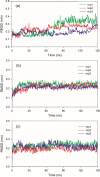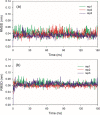Indole alkaloids as potential candidates against COVID-19: an in silico study
- PMID: 35546368
- PMCID: PMC9094126
- DOI: 10.1007/s00894-022-05137-4
Indole alkaloids as potential candidates against COVID-19: an in silico study
Abstract
COVID-19 has recently grown to be pandemic all around the world. Therefore, efforts to find effective drugs for the treatment of COVID-19 are needed to improve humans' life quality and survival. Since the main protease (Mpro) of SARS-CoV-2 plays a crucial role in viral replication and transcription, the inhibition of this enzyme could be a promising and challenging therapeutic target to fight COVID-19. The present study aims to identify alkaloid compounds as new potential inhibitors for SARS-CoV-2 Mpro by the hybrid modeling analyses. The docking-based virtual screening method assessed a collection of alkaloids extracted from over 500 medicinal plants and sponges. In order to validate the docking process, classical molecular dynamic simulations were applied on selected ligands, and the calculation of binding free energy was performed. Based on the proper interactions with the active site of the SARS-CoV-2 Mpro, low binding energy, few side effects, and the availability in the medicinal market, two indole alkaloids were found to be potential lead compounds that may serve as therapeutic options to treat COVID-19. This study paves the way for developing natural alkaloids as stronger potent antiviral agents against the SARS-CoV-2.
Keywords: Docking; Indole alkaloids; MM-PBSA; Molecular dynamic simulations; SARS-CoV-2 main protease inhibitor; Virtual screening.
© 2022. The Author(s), under exclusive licence to Springer-Verlag GmbH Germany, part of Springer Nature.
Conflict of interest statement
The authors declare no competing interests.
Figures










Similar articles
-
Investigating the structure-activity relationship of marine polycyclic batzelladine alkaloids as promising inhibitors for SARS-CoV-2 main protease (Mpro).Comput Biol Med. 2022 Aug;147:105738. doi: 10.1016/j.compbiomed.2022.105738. Epub 2022 Jun 17. Comput Biol Med. 2022. PMID: 35777088 Free PMC article.
-
A Computational Study of Carbazole Alkaloids from Murraya koenigii as Potential SARS-CoV-2 Main Protease Inhibitors.Appl Biochem Biotechnol. 2023 Jan;195(1):573-596. doi: 10.1007/s12010-022-04138-6. Epub 2022 Sep 15. Appl Biochem Biotechnol. 2023. PMID: 36107386 Free PMC article.
-
Integrated bioinformatics-cheminformatics approach toward locating pseudo-potential antiviral marine alkaloids against SARS-CoV-2-Mpro.Proteins. 2022 Sep;90(9):1617-1633. doi: 10.1002/prot.26341. Epub 2022 Apr 13. Proteins. 2022. PMID: 35384056 Free PMC article.
-
The naturally-derived alkaloids as a potential treatment for COVID-19: A scoping review.Phytother Res. 2022 Jul;36(7):2686-2709. doi: 10.1002/ptr.7442. Epub 2022 Mar 30. Phytother Res. 2022. PMID: 35355337 Free PMC article.
-
Bioactive Alkaloids from Genus Aspergillus: Mechanistic Interpretation of Their Antimicrobial and Potential SARS-CoV-2 Inhibitory Activity Using Molecular Modelling.Int J Mol Sci. 2021 Feb 13;22(4):1866. doi: 10.3390/ijms22041866. Int J Mol Sci. 2021. PMID: 33668523 Free PMC article. Review.
Cited by
-
Green and rapid and instrumental one-pot method for the synthesis of imidazolines having potential anti-SARS-CoV-2 main protease activity.Sustain Chem Pharm. 2023 Sep;34:101136. doi: 10.1016/j.scp.2023.101136. Epub 2023 Jun 5. Sustain Chem Pharm. 2023. PMID: 37333050 Free PMC article.
-
Indole-Based Compounds as Potential Drug Candidates for SARS-CoV-2.Molecules. 2023 Sep 13;28(18):6603. doi: 10.3390/molecules28186603. Molecules. 2023. PMID: 37764378 Free PMC article. Review.
-
Unraveling the impact of nitric oxide, almitrine, and their combination in COVID-19 (at the edge of sepsis) patients: a systematic review.Front Pharmacol. 2024 Jan 22;14:1172447. doi: 10.3389/fphar.2023.1172447. eCollection 2023. Front Pharmacol. 2024. PMID: 38318311 Free PMC article.
References
-
- Sharifkashani S, Bafrani MA, Khaboushan AS, Pirzadeh M, Kheirandish A, Yavarpour Bali H, Hessami A, Saghazadeh A, Rezaei N. Angiotensin-converting enzyme 2 (ACE2) receptor and SARS-CoV-2: potential therapeutic targeting. Eur J Pharmacol. 2020;884:173455. doi: 10.1016/j.ejphar.2020.173455. - DOI - PMC - PubMed
-
- Gupta SP (2017) Viral proteases and their inhibitors. 1st Edition, Academic Press.
MeSH terms
Substances
Grants and funding
LinkOut - more resources
Full Text Sources
Miscellaneous

